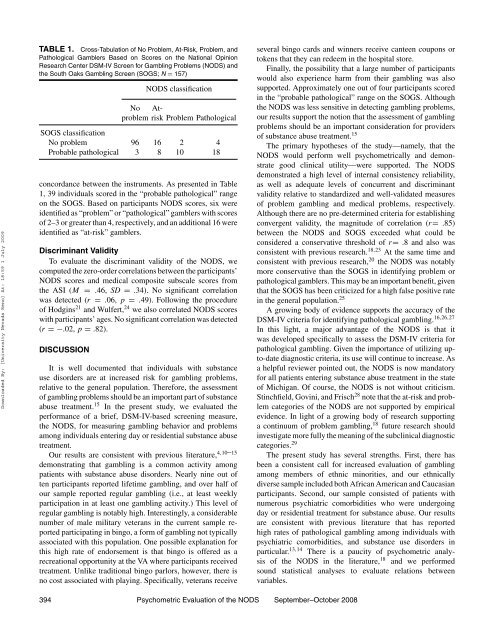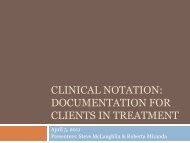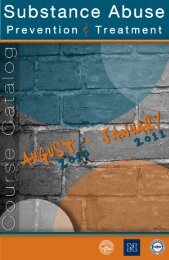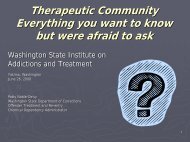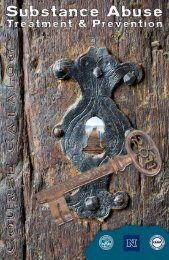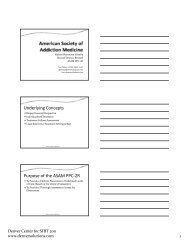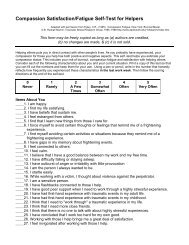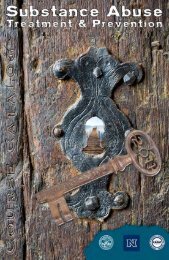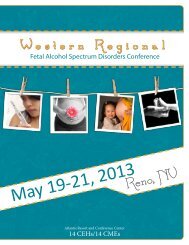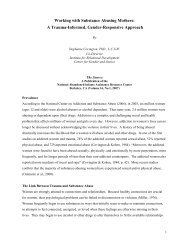Wickwire, E. M., Jr., Burke, R. S., Brown, S. A., Parker, J. D. ... - CASAT
Wickwire, E. M., Jr., Burke, R. S., Brown, S. A., Parker, J. D. ... - CASAT
Wickwire, E. M., Jr., Burke, R. S., Brown, S. A., Parker, J. D. ... - CASAT
Create successful ePaper yourself
Turn your PDF publications into a flip-book with our unique Google optimized e-Paper software.
Downloaded By: [University Nevada Reno] At: 18:59 1 July 2009TABLE 1. Cross-Tabulation of No Problem, At-Risk, Problem, andPathological Gamblers Based on Scores on the National OpinionResearch Center DSM-IV Screen for Gambling Problems (NODS) andthe South Oaks Gambling Screen (SOGS; N = 157)NODS classificationNo Atproblemrisk Problem PathologicalSOGS classificationNo problem 96 16 2 4Probable pathological 3 8 10 18concordance between the instruments. As presented in Table1, 39 individuals scored in the “probable pathological” rangeon the SOGS. Based on participants NODS scores, six wereidentified as “problem” or “pathological” gamblers with scoresof 2–3 or greater than 4, respectively, and an additional 16 wereidentified as “at-risk” gamblers.Discriminant ValidityTo evaluate the discriminant validity of the NODS, wecomputed the zero-order correlations between the participants’NODS scores and medical composite subscale scores fromthe ASI (M = .46, SD = .34). No significant correlationwas detected (r = .06, p = .49). Following the procedureof Hodgins 21 and Wulfert, 24 we also correlated NODS scoreswith participants’ ages. No significant correlation was detected(r =−.02, p = .82).DISCUSSIONIt is well documented that individuals with substanceuse disorders are at increased risk for gambling problems,relative to the general population. Therefore, the assessmentof gambling problems should be an important part of substanceabuse treatment. 15 In the present study, we evaluated theperformance of a brief, DSM-IV-based screening measure,the NODS, for measuring gambling behavior and problemsamong individuals entering day or residential substance abusetreatment.Our results are consistent with previous literature, 4,10–15demonstrating that gambling is a common activity amongpatients with substance abuse disorders. Nearly nine out often participants reported lifetime gambling, and over half ofour sample reported regular gambling (i.e., at least weeklyparticipation in at least one gambling activity.) This level ofregular gambling is notably high. Interestingly, a considerablenumber of male military veterans in the current sample reportedparticipating in bingo, a form of gambling not typicallyassociated with this population. One possible explanation forthis high rate of endorsement is that bingo is offered as arecreational opportunity at the VA where participants receivedtreatment. Unlike traditional bingo parlors, however, there isno cost associated with playing. Specifically, veterans receiveseveral bingo cards and winners receive canteen coupons ortokens that they can redeem in the hospital store.Finally, the possibility that a large number of participantswould also experience harm from their gambling was alsosupported. Approximately one out of four participants scoredin the “probable pathological” range on the SOGS. Althoughthe NODS was less sensitive in detecting gambling problems,our results support the notion that the assessment of gamblingproblems should be an important consideration for providersof substance abuse treatment. 15The primary hypotheses of the study—namely, that theNODS would perform well psychometrically and demonstrategood clinical utility—were supported. The NODSdemonstrated a high level of internal consistency reliability,as well as adequate levels of concurrent and discriminantvalidity relative to standardized and well-validated measuresof problem gambling and medical problems, respectively.Although there are no pre-determined criteria for establishingconvergent validity, the magnitude of correlation (r= .85)between the NODS and SOGS exceeded what could beconsidered a conservative threshold of r= .8 and also wasconsistent with previous research. 18,23 At the same time andconsistent with previous research, 20 the NODS was notablymore conservative than the SOGS in identifying problem orpathological gamblers. This may be an important benefit, giventhat the SOGS has been criticized for a high false positive ratein the general population. 25A growing body of evidence supports the accuracy of theDSM-IV criteria for identifying pathological gambling. 16,26,27In this light, a major advantage of the NODS is that itwas developed specifically to assess the DSM-IV criteria forpathological gambling. Given the importance of utilizing upto-datediagnostic criteria, its use will continue to increase. Asa helpful reviewer pointed out, the NODS is now mandatoryfor all patients entering substance abuse treatment in the stateof Michigan. Of course, the NODS is not without criticism.Stinchfield, Govini, and Frisch 28 note that the at-risk and problemcategories of the NODS are not supported by empiricalevidence. In light of a growing body of research supportinga continuum of problem gambling, 18 future research shouldinvestigate more fully the meaning of the subclinical diagnosticcategories. 29The present study has several strengths. First, there hasbeen a consistent call for increased evaluation of gamblingamong members of ethnic minorities, and our ethnicallydiverse sample included both African American and Caucasianparticipants. Second, our sample consisted of patients withnumerous psychiatric comorbidities who were undergoingday or residential treatment for substance abuse. Our resultsare consistent with previous literature that has reportedhigh rates of pathological gambling among individuals withpsychiatric comorbidities, and substance use disorders inparticular. 13,14 There is a paucity of psychometric analysisof the NODS in the literature, 18 and we performedsound statistical analyses to evaluate relations betweenvariables.394 Psychometric Evaluation of the NODS September–October 2008


